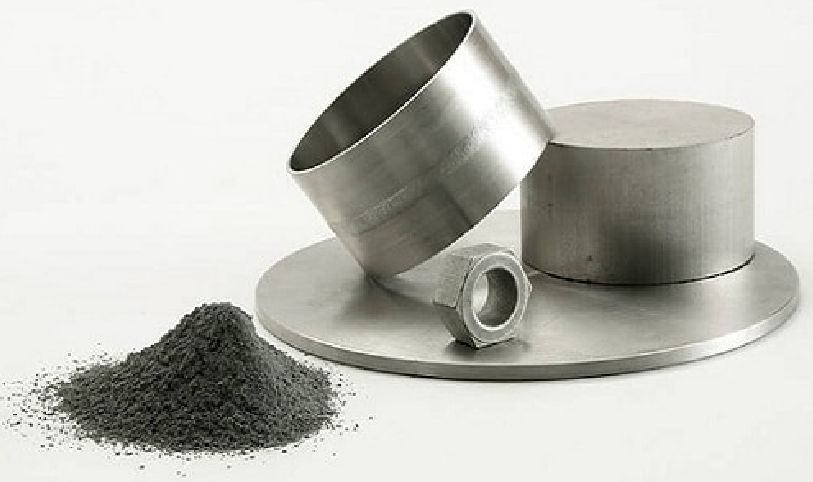The List Of Abundant Refractory Metals

The List of Abundant Refractory Metals
Tungsten, tantalum, molybdenum, columbium, vanadium, and chromium may be classed as relatively abundant refractory metals; that is, free world reserves of contained metal are over 100,000 tons for each metal.

Abundant Refractory Metals
The first four show promise in a considerably higher temperature range than the last two, and sometimes the term "refractory metals" is used narrowly to mean only these four elements and their alloys. At the present time, these four metals are the only metals that are reasonably abundant whose alloys show promise of high strength above 2000 F.
It is these elements that are being used or studied for such ultrahigh temperature applications as rocket nozzles, leading edges and "hot structures" of certain reentry vehicles, special electronic components, advanced gas turbines, and ramjet engines.

Refractory Metals Bars
Tungsten, molybdenum, vanadium, chromium, and to a lesser extent columbium have been used for years as alloying elements in other metals, especially iron and steel.
In addition, tungsten and molybdenum have been used in the lamp and electron-tube industry for more than 50 years. Commercially pure tantalum has been used for many years, in modest quantities, as a structural metal in the chemical industry and elsewhere for its corrosion resistance.
Development of Abundant Refractory Metals
It is only since World War II, however, that these metals have been seriously considered for use as elevated-temperature structural metals in their own right. At the present time, a sizable fraction of their total production is for structural uses.
Within the past decade, it has become evident that structural materials having higher service temperatures than nickel- and cobalt-base alloys are desirable to achieve higher power and efficiency for turbojet, ramjet, and rocket engines. Consequently, several extensive research and development programs have been initiated to evaluate the abundant refractory metals for critical high-temperature applications.

Refractory Metals
Development work has been difficult with these metals because of their low-temperature brittleness (except for tantalum and columbium), their tendency to oxidize at elevated temperatures, problems in achieving increased purity, problems in forging and welding, etc.
Nevertheless, new techniques for melting, purifying, consolidating, coating, fabricating, and welding have been developed which have overcome many of the original problems. At present, several of the abundant refractory metals and alloys are being used as structural materials in several high-temperature applications.
Applications of Abundant Refractory Metals
Tungsten (W): With the highest melting point of all metals (3,422°C), high density, and excellent thermal stability, tungsten is widely used in aerospace for rocket nozzles, in electronics for filaments, and in high-temperature furnaces. It is also a key alloying element in steel to enhance hardness and strength.
Tantalum (Ta): Known for its high melting point (3,017°C), corrosion resistance, and excellent conductivity, tantalum is used in chemical processing equipment, surgical implants, and capacitors in electronics. Its resistance to corrosive environments makes it invaluable in the chemical industry.
Molybdenum (Mo): Molybdenum has a high melting point (2,623°C), excellent thermal conductivity, and high strength. It is used in furnace components, electrical contacts, and as an alloying agent in steel to improve strength and corrosion resistance. It is also critical in aerospace and defense applications.
Columbium (Niobium) (Nb): With a high melting point (2,477°C) and excellent superconducting properties, columbium is used in superconducting magnets, aerospace alloys, and as an additive in steel to enhance toughness and high-temperature performance.
Vanadium (V): Vanadium has a high melting point (1,910°C) and excellent strength-to-weight ratio. It is primarily used as an alloying element in steel to improve strength and fatigue resistance, as well as in aerospace and battery technologies.
Chromium (Cr): Chromium has a high melting point (1,907°C) and excellent corrosion resistance. It is widely used in stainless steel production, plating, and high-temperature alloys, making it essential in harsh environments.
Conclusion
Tungsten, tantalum, molybdenum, columbium (niobium), vanadium, and chromium are abundant refractory metals with exceptional high-temperature strength and corrosion resistance. Tungsten, tantalum, molybdenum, and columbium, in particular, are vital for ultrahigh-temperature applications like rocket nozzles, reentry vehicles, and advanced engines. For more information and refractory metals and materials, please check Advanced Refractory Materials (ARM).
{{item.content}}
LEVE A REPLY
{{item.children[0].content}}
{{item.content}}






